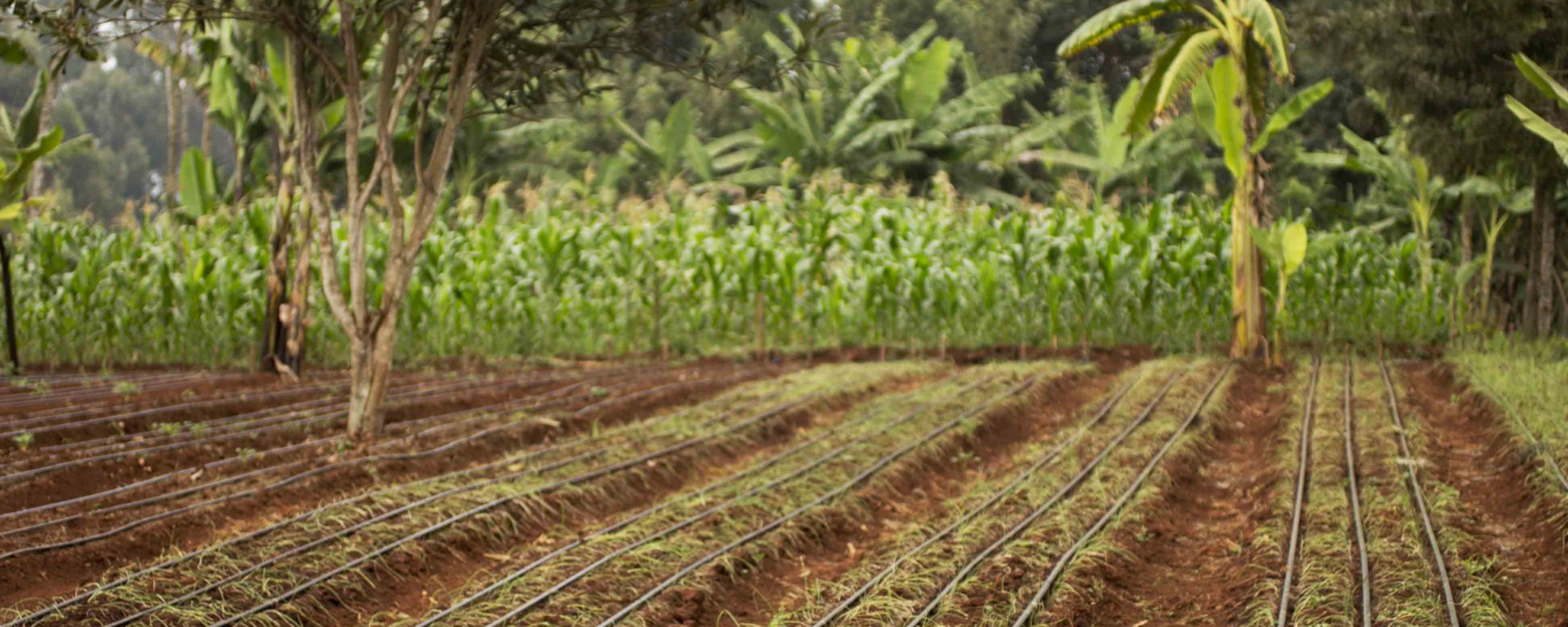

Chris Muthoka is a farmer in Machakos County, about 43 miles [70 kilometers] southeast of Nairobi along Mombasa Road, the main highway between the country’s two largest cities. He grows capsicum–pepper plants–across four acres of land. An extremely water-intensive crop, keeping the plants hydrated used to be challenge in a country with erratic rainfall and frequent droughts.
But Muthoka is one of many farmers across Kenya turning to solar power to help irrigate crops. He uses an AgroSolar Irrigation Kit, a cheap, easy-to-install, and low-maintenance drip-irrigation system produced by local NGO Sunculture. During the day, the solar panel collects sunlight and uses the energy to pump water from a reservoir, river, well, or other water source into an above-ground storage drum. Then, whenever the crops need water, farmers can just release the valve, day or night, and let the water trickle out through tubes across their fields.
The kits are bespoke and can be scaled up to handle as much as 40 acres of farmland, but they certainly aren’t cheap. A complete installation–covering the irrigation system, the solar panels and pumps, a 5,000 liter storage tank, and labor–to supply a single acre of land can cost in the region of 380,000KSH [$3,736]. Still, Muthoka said it’s worth it. “Although the initial capital outlay might be a challenge to some farmers, once bought it needs no running costs,” he pointed out. “I’m able to supply fresh produce throughout the year to my customers.”
Sunculture’s Kathryn Weichel told me that while the alternative–diesel pumps–are more affordable to start, they make irrigation a costly affair in the long term, especially for single-family farms. “Our aim is to make irrigation affordable and [of] quality,” she explained. The organization has a highly trained technical team involved in research and development, and is training farmers in the use and maintenance of the kit.
With climate change is creating more and more erratic rainfall, farmers in Kenya are trying to figure out how to keep their fields watered consistently. Only around 17 percent of Kenya’s land area can sustain agriculture on rainfall alone–elsewhere, farmers have to tap into other water sources to feed their crops.
This has spurred demand for affordable and easy-to-run water pumps across the country, and environmentally friendly pumps (which don’t contribute to climate change) even more so. Another organization working on the problem is Kickstart–a Kenyan nonprofit specializing in irrigation technology specifically for poor farmers.
Kickstart was founded in 1991, originally as ApproTEC. In its 25 years, the organization’s manual irrigation pumps have left a mark on millions of people in Kenya and elsewhere in Africa. They’ve alleviated poverty, improved food security, and made it easier for people to adjust to climate change.
Mosses Odongo, head of sales and distribution at Kickstart’s headquarters in Nairobi, showed me one of their first models, powered by pedaling. It’s heavier, larger, and less efficient than today’s main model–the “MoneyMaker Max,” an upright pump that costs farmers $70 each. (Its name refers to its ability to increase the incomes of the farmers who use them.)
He explained: “[It’s] found a market not only in Kenya but the entirety of east, south, and west Africa. It can draw water from a depth of 23 feet and pump it to a height of 46 feet, and 600 meters horizontally, and irrigate an acre of land.” Even though the pumps require physical strength to operate, Odongo claims that part of the success of the MoneyMaker pumps is that people of all ages and genders can operate them.
But, like SunCulture, Kickstart has also developed its own solar-powered pump. It costs $400 and, according to Titus Wafula, head of the technical team involved in its development, it can pump 4.5 gallons [17 liters] per minute from a depth of over 16 feet [or exactly five meters]. On a good day, with plenty of sunshine, it pumps somewhere between 800 to 1,050 gallons [3,000″”4000 liters]. There’s also an extra tool available, a solar boost converter that uses a technique called Maximum Power Point Tracking (MPPT) to improve the efficiency of each unit on days with less sunshine.
Seventy units have been sold since the launch and, perhaps unsurprisingly, women farmers have been even more receptive to the solar pumps than men. “It has come to our realization that apart from irrigation purposes, in most homesteads with shallow boreholes, women are the ones who draw water using buckets tied on ropes. The availability of a solar pump relieves them the burden of drawing water,” Wafula noted. Each pump can irrigate a quarter of an acre of land, and comes with an automated irrigation system and storage tank.

Importantly, the technology behind the pump was developed entirely in-house at Kickstart. “We started exploring ways of designing a solar pump, because we thought they could be affordable to farmers, unlike the fossil fuel-powered ones,” Odongo said. Kickstart’s technologies, he explained, are developed by Kenyans for the African market. “Due to investing in research and development, we have been able to satisfy the needs of our clients while still ensuring they are affordable.”
Wafula reiterates his colleague’s comments, saying that they hire graduates from local universities and offer them further in-house training. Kickstart also has a devoted technical team that works on prototype design and testing.
Plus, Odongo is elated by the impact of the technologies on the lives of poor farmers. He says data from their monitoring and evaluation team indicate that among households and communities that have embraced their technologies, poverty is declining. “Households using our pumps, for instance, have improved nutrition and are able to take their children and meet medical expenses,” he said.
Kickstart is also branching out into other areas, including housing–or, rather, housing supplies, in response to frequent shortages of things like bricks in Kenya. The nonprofit has invented a press that uses soil mixed with cement to produce building blocks that don’t need to be cured in an oven before use. Or there’s the oil press, for farmers to get the most out of their sesame or sunflower crops–it can make over a hundred gallons [hundreds of liters] of oil a day, if necessary. Or, there’s a hay baler, which can manage more than 200 bales (each weighing around 44 pounds, or 20 kilograms) per day. In drought-ridden climates, bales are vital for saving up feed for livestock.
Kickstart also works with both NGOs and governmental bodies to try and sell its products–but success brings with it a new challenge: falling water levels in Kenyan rivers, springs, and groundwater sources. “We are compelled to assess the customer’s water source to advise them accordingly. This is to spare them from buying a pump, and failing to use it [because of the] unavailability of enough water,” said Odongo.
The scenario has forced Kickstart to liaise with organizations involved in rainwater harvesting and conservation to ensure that farmers don’t use more water than they should. His main concern, however, is that the government has failed to offer tax concessions that could cut down production costs. “Underlying our initiative is service to smallholder farmers. We don’t want to add misery to them. Unfortunately the government has started taxing our products, thus pushing the burden to farmers,” he lamented.
As climate change makes rainfall increasingly more inconsistent, solar irrigation will surely not be the final frontier for companies like Kickstart and SunCulture questing to solve the problems of Kenyan dependent on farms across the country.


How We Get To Next was a magazine that explored the future of science, technology, and culture from 2014 to 2019. This article is part of our Power Up section, which looks at the future of electricity and energy. Click the logo to read more.
